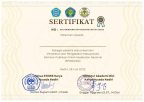Lavender Aromatherapy Contributes to Reducing Dysmenorrhea Pain in Adolescent Girls
Keywords:
Dysmenorrhea, Pain, AromatherapyAbstract
Dysmenorrhea has a significant impact on life. 43.3% of girls were reported to be absent from school, 74.9% experienced illness in class and 77.2% had difficulty doing sports activities, emotional fluctuations in the form of anger, aggression, stress, depression, guilt, loneliness, self-dislike, suicidal ideation and decreased quality of life. The purpose of this study was to determine the effectiveness of lavender aromatherapy in reducing dysmenorrhea. The research design was a quasi-experimental one group pre-test post design. It was carried out in the working area of the Rumday Health Center, Central Maluku from April 22 to May 14, 2024. The population was all 60 adolescent girls who experienced dysmenorrhea. A sample of 52 respondents was selected by simple random sampling. The intervention was in the form of giving 3 drops of Lavender aromatherapy for 30 minutes on the second day of menstruation. Pain was measured before and after the intervention using the Visual Analog Scale (VAS) instrument. This research variable was single and paired, namely dysmenorrhea pain before and after lavender aromatherapy. Data analysis using the Wilcoxon Sign Rank Test. There is a difference in pain levels before the intervention. Before the intervention, the controlled severe level was 44.2% and severe pain was not controlled 26.9%, inversely proportional to dysmenorrhea pain after the intervention, namely mild pain 40.4%, moderate pain 23.1% and no pain s 21.2%. The Wilcoxon Sign Rank Test Statistical Test with a value of p = 0.000 <α = 0.05, which means there is a significant difference between pain before and after the intervention. Aromatherapy can provide a stimulating effect, provide a calming sensation, a calming sensation for the brain, balance, a calming sensation from stress, relaxation of the mind and body so that dysmenorrhea pain is reduced.
Downloads
Published
Issue
Section
License
Copyright (c) 2024 Proceedings of the National Health Scientific Publication Seminar

This work is licensed under a Creative Commons Attribution 4.0 International License.







